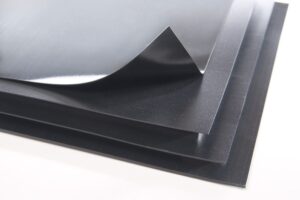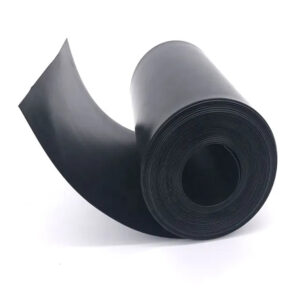What types of geomembranes are there?
Geomembrane is a synthetic material used in engineering construction, environmental protection and other fields. It is usually made of polymer materials such as polyethylene (PE) or polypropylene (PP). It has anti-seepage, anti-corrosion, anti-aging and other properties, and is widely used in waterproofing, isolation, penetration control and other engineering projects.
High density polyethylene geomembrane (HDPE):
Features: It has high tensile strength and puncture resistance, and is suitable for engineering projects with higher requirements, such as landfills, sewage treatment plants, etc.
Application: Mainly used in anti-seepage, isolation and other engineering projects.
Low density polyethylene geomembrane (LDPE):
Features: Relatively soft and easy to extend, but with low tensile strength, it is suitable for engineering projects that do not require high tensile strength.
Application: Generally used in light engineering projects such as agriculture and gardening.
Linear low density polyethylene geomembrane (LLDPE):
Features: It has good heat resistance and aging resistance, and is suitable for some engineering projects that require higher material performance.
Application: Widely used in engineering waterproofing, pond anti-seepage and other projects.
Polypropylene geomembrane (PP):
Features: Excellent chemical corrosion resistance, high resistance to chemicals such as acids and alkalis.
Application: Suitable for engineering projects with high chemical environment requirements, such as landfills, etc.
Cross-linked polyethylene geomembrane (XPE):
Features: It has high anti-aging properties and mechanical properties, as well as excellent anti-penetration properties.
Application: Suitable for high-demand waterproofing, anti-seepage and other engineering projects.
Composite geomembrane:
Features: It is composed of a laminated combination of two or more different materials, combining the advantages of various materials, such as the composite of HDPE and LLDPE.
Application: Appropriate composite geomembrane can be selected according to specific project requirements to provide more comprehensive anti-seepage performance.
Anti-seepage cloth:
Features: Usually made of polypropylene, polyester and other materials, it has strong tensile strength and puncture resistance.
Application: Widely used in anti-seepage protection of roads, tunnels, dams and other projects.
The geomembrane types listed above are only some of them. With the advancement of science and technology and the continuous development of engineering applications, new materials and types may also appear. When selecting a geomembrane, it is necessary to make a reasonable selection based on specific project requirements, environmental conditions and material characteristics to ensure the smooth progress of the project.

Geomembrane specifications
Geomembrane specifications can vary based on specific project needs. The following are some common geomembrane specifications, but please note that specific specifications will vary depending on the project:
Thickness: The thickness of a geomembrane is usually expressed in millimeters (mm). Common thicknesses include 0.5mm, 1.0mm, 1.5mm, 2.0mm, etc. The choice of thickness depends on the anti-seepage requirements of the project and the pressure it will bear.
Width: The width of geomembrane is usually between 2 meters and 8 meters, and can be customized according to the needs of the project. Wider membranes reduce the number of seams and increase construction efficiency.
Length: Geomembranes are usually supplied in rolls, and the length can be customized according to project requirements. Common roll lengths are 50 meters, 100 meters, 200 meters or longer.
Color: Geomembranes are usually black because black is good for absorbing sunlight and helps extend the service life of the membrane. However, in some special cases, other colors of geomembranes may also be selected.
Tensile strength: The tensile strength of geomembrane is an important performance parameter, usually expressed in megapascals (MPa). Different types of geomembranes have different tensile strengths, and appropriate specifications can be selected according to the needs of the engineering project.
Puncture resistance: The puncture resistance of geomembrane refers to the resistance of the membrane material to puncture by external sharp objects. This is usually measured in standardized tests to ensure that the membrane is not susceptible to damage during use.
Anti-aging performance: The geomembrane needs to have good resistance to ultraviolet radiation and oxidative aging to ensure long-term stability.
Permeability coefficient: The permeability coefficient of a geomembrane refers to its permeability to liquid or gas. Geomembranes are usually required to have certain anti-penetration properties in engineering projects.
These specifications will vary depending on the needs of the specific project and the environmental conditions faced. When selecting geomembrane specifications, you should consult a professional engineer or make a selection based on engineering design requirements to ensure that the geomembrane plays its best role in the project.

HDPE Geomembrane Technical Specifications
HDPE (high-density polyethylene) geomembrane is a material commonly used in anti-seepage and waterproofing projects. The following are general technical specifications for HDPE geomembranes, but please note that specific specifications may vary depending on the manufacturer and project requirements:
thickness:
HDPE geomembranes are usually available in different thicknesses, with a typical range likely to be between 0.5 mm and 3 mm.
Width and length:
The width and length are determined according to the project needs and can be customized according to the actual situation.
Mass density:
The mass density of HDPE geomembrane affects its anti-permeability performance, which is often expressed in grams per square meter (g/m²) or grams per square centimeter (g/cm²).
tensile strength:
HDPE geomembrane has tensile strength in the tensile direction and transverse direction to ensure its endurance during installation and use.
Puncture resistance:
The puncture resistance of HDPE geomembrane to sharp objects ensures that it is not easily punctured in actual use.
Permeability coefficient:
The permeability coefficient of HDPE geomembrane indicates its ability to block water, usually measured in terms of permeability per square meter per day (g/m²/day).
UV stability:
UV resistance to ensure resistance to aging and breakage when exposed to outdoor conditions.
Thermal shrinkage rate:
Thermal shrinkage of HDPE geomembrane, especially in high temperature environments, ensures that excessive deformation does not occur during use.
Seam strength:
For the connection of multiple HDPE geomembrane segments, the strength of the joints is the key indicator.
environmental impact:
The ecological and environmental performance of HDPE geomembrane, including its impact on soil and water bodies.
This is a general overview of specifications only; specific technical specifications should be obtained from the product documentation provided by the supplier or manufacturer.
Ensure you select the appropriate specification HDPE geomembrane for your project and follow the relevant installation and usage guidelines to ensure its performance and durability
Author

Founded in 2002, Tinhy's team focuses on the manufacturing, marketing, installation, application and research and development of geosynthetic materials.
View all posts






